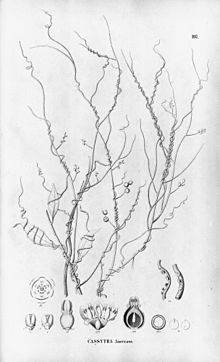Cassytha filiformis
| Cassytha filiformis | |
|---|---|

| |
| Scientific classification | |
| Kingdom: | Plantae |
| Clade: | Tracheophytes |
| Clade: | Angiosperms |
| Clade: | Magnoliids |
| Order: | Laurales |
| Family: | Lauraceae |
| Genus: | Cassytha |
| Species: | C. filiformis
|
| Binomial name | |
| Cassytha filiformis | |
| SynonymsThe Plant List | |
| |
Cassytha filiformis, common name love-vine, is a species of obligate parasitic vine in the family Lauraceae. The species has a native pantropical distribution encompassing the Americas, Indomalaya, Australasia, Polynesia and tropical Africa [2][3] In the Caribbean region, it is one of several plants known as "Love vine" because it has a reputation as an aphrodisiac.[4]
Cassytha filiformis is a twining vine with an orange to pale green stem. Leaves are reduced to scales about 1 mm long. Flowers are borne in spikes or sometimes solitary. There are six tepals, each 0.1-2.0 mm long. Fruit is a drupe about 7 mm in diameter.[2]
The 1889 book 'The Useful Native Plants of Australia records that the "This and other species of Cassytha are called " Dodder-laurel." The emphatic name of "Devil's guts" is largely used. It frequently connects bushes and trees by cords, and becomes a nuisance to the traveller. "This plant is used by the Brahmins of Southern India for seasoning their buttermilk. (Treasury of Botany?)".[5]



References
- ^ "Cassytha filiformis". Germplasm Resources Information Network. Agricultural Research Service, United States Department of Agriculture. Retrieved 2013-01-28.
- ^ a b Flora of North America vol 3
- ^ D. S. Correll & M. C. Johnston. 1970. Manual of the Vascular Plants of Texas. University of Texas at Dallas.
- ^ Esbaugh, W. Hardy; McClure, Susan A. & Bolyard, Judith L. Bush Medicine Studies, Andros Island, Bahamas. Proceedings of the first symposium on the botany of the Bahamas June 11–14, 1985. Ed. Robert R. Smith., San Salvador, Bahamas.
- ^ J. H. Maiden (1889). The useful native plants of Australia : Including Tasmania. Turner and Henderson, Sydney.
External links
- Love Vine at Center for Aquatic and Invasive Plants, University of Florida
- Cassytha filiformis in West African plants – A Photo Guide.
- Lauraceae
- Plants described in 1753
- Pantropical flora
- Parasitic plants
- Flora of Australia
- Flora of Florida
- Flora of Texas
- Flora of South America
- Flora of Central America
- Flora of Mexico
- Flora of the Caribbean
- Flora of China
- Flora of Japan
- Flora of Madagascar
- Flora of South Africa
- Flora of tropical Asia
- Flora of the Lesser Sunda Islands
- Flora of Hawaii
